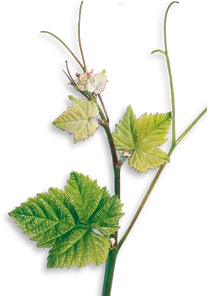Borraçal (PT)
Variety: red | Category III | Portugal


General Information
Borraçal


Origin: Gyrão (1832) noted this variety in Porto, Penafiel and Basto (Vinho Verde). Vila Maior (1875) also wrote about cultivation of this variety in the region.
Chief areas of distribution: Lima sub-region (Vinho Verde).
Official synonym(s) (national and OIV): Unknown.
Historic and regional synonyms: Olho de Sapo, Cainho Gordo (Cincinnato).
Homonym(s): Unknown.
Area under cultivation: 1,375 ha.
New plantings: Below 0.2%.
Trend: None.
Varietal variability: Medium.
Availability of propagating material: RNSV polyclonal material. RNSV clone being prepared.
Molecular Profile (OIV)
Regional Classification
Morphology
Phenology
Vegetative Potential
Viticultural Parameters
Oenology
Variety Characteristics
| VVMD5 | VVMD7 | VVMD27 | VrZag62 | VrZag79 | VVS2 | ||||||
| Allele1 | Allele2 | Allele1 | Allele2 | Allele1 | Allele2 | Allele1 | Allele2 | Allele1 | Allele2 | Allele1 | Allele2 |
| 232 | 238 | 235 | 235 | 181 | 185 | 194 | 194 | 247 | 247 | 135 | 137 |
DOC quality wine: Vinho Verde, Lima sub-region.
Regional wine: Minho.
Young shoot (form of tip): Open, with crimson red tip, medium to dense erect hairs.
Young leaf: Green with bronze streaks. Erect hairs of medium density on lower side of blade.
Young shoot: Light reddish stripes, green nodes.
Inflorescence (sex of flower): Hermaphrodite.
Mature leaf: Medium size, pentagonal, three lobes, medium green blade, flat, medium blistering of upper side of blade; medium convex teeth; Closed V-shaped petiolar sinus with strongly overlapping lobes. Open V-shaped upper lateral sinuses. Dense erect hairs on lower side of blade.
Bunch: Small, conical, medium-dense, peduncle of medium length.
Berry: Round, medium to large, depending on the clone. Blue-black colour varies considerably between clones, but is never very intense. Skin of medium thickness, medium to soft flesh.
Time of bud burst: Normal, 6 days after the Castelão.
Flowering: Early, 1 day after the Castelão
Berry (colour change): Late, 10 days after the Castelão.
Berry (harvest ripe): Late, one week after the Castelão.
Vigour of shoot growth: High.
Pruning weight:: 3,700 kg/ha.
Shoot attitude (habit): Semi-erect, some particularly long, plagiotropic and drooping shoots.
Length of internodes: Short at the base, thereafter of medium length.
Shoot length: Long to very long.
Tendency to form lateral shoots: High.
Rate of multiple bud bursts: Low.
Bud fertility index: 1.8 flowers per shoot.
Yield: Medium (8,000 – 16,000 kg/ha). RNSV statistical value: 4.29 kg/vine (Average of at least 40 clones in Arcos de Valdevez over 7 years).
Yield consistency: Inconsistent.
Crop uniformity: Uniform.
Winkler Index: 1,318.
Sensitivity to abiotic factors: No particular sensitivity.
Susceptibility to fungal diseases: Susceptible to Oidium, very susceptible to Bunch Rot (Botrytis).
Susceptibility to Pests: No particular pests.
Bunch size: Small 188 - 253 g.
Bunch density: Medium.
Berry skin: Medium firmness.
Seeds per berry: 1.8.
Vineyard conduction system: Cincinnato (1900) said that this variety was usually high trained in trees, according to the uveira or vinha de enforcado training systems. It adapts well to the cordon training system.
Soil requirement: Dry soils.
Climatic requirements: Moist warm regions. Extreme solar irradiation causes sunburn.
Vine density: Vine spacing must always be greater than 1 m apart.
Rootstock: Compatible with 196 -17, 161-49, SO4, 3309C.
Irrigation: Not common; should only be considered in cases of extreme drought stress, or with young vines.
Incidence of coulure/millerandage: Less susceptible to coulure than to millerandage.
Spoilage of mature berries: Normally minimal, but needs to be harvested immediately after heavy rainfall.
Risk of bird damage: Low.
Machine harvest suitability: Not common, but certainly possible, depending on the training system. Oenology
Wine type: Red Vinho Verde.
Potential alcohol content: Low, 10 - 11% vol., since variety is used to produce light wines. RNSV statistical value: 9,69% vol. (Average of at least 40 clones in Arcos de Valdevez over 2 years).
Natural acidity of must: Very high in malic acid and total acids. RNSV statistical value: 11.51 g/l total acid (Average of at least 40 clones in Arcos de Valdevez over 2 years)
Total anthocyanins: RNSV statistical value: 420.48 mg/l (Average of at least 40 clones in Arcos de Valdevez over 2 years).
Total phenols index (at 280 nm) of must: RNSV statistical value: 20.4 (Average of at least 40 clones in Arcos de Valdevez over 2 years).
Risk of oxidation of must: High.
Colour intensity of wine: Medium.
Wine colour tonality: Ruby red.
Risk of oxidation of wine: High.
Ageing Potential: Medium.
Blending recommendation: Vinhão.
Wine Descriptors: Produces wines with unusually high malic acid and total acids. In comparison to the Azal Tinto, Vinhão and Espadeiro the wines have a ruby red colour with an aroma particular to the variety. Palatable and well-balanced. (EVAG)
Wine quality: Good.
Variety Characteristics: Traditionally, a variety of the North. Usually high trained on trees, according to the ancient arbustrum tradition. Cultivation of the variety is limited to the Minho region, from which it gets the unique high acidity typical of red Vinho Verde wine. This particular level of acidity takes some getting used to for those who are not familar with the region.

